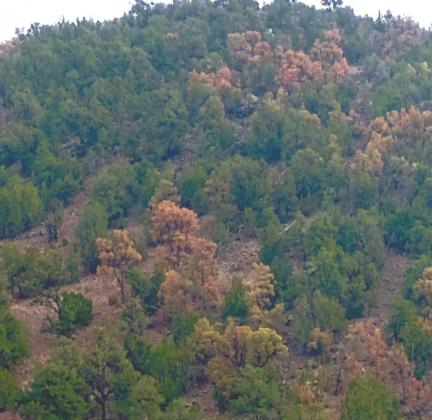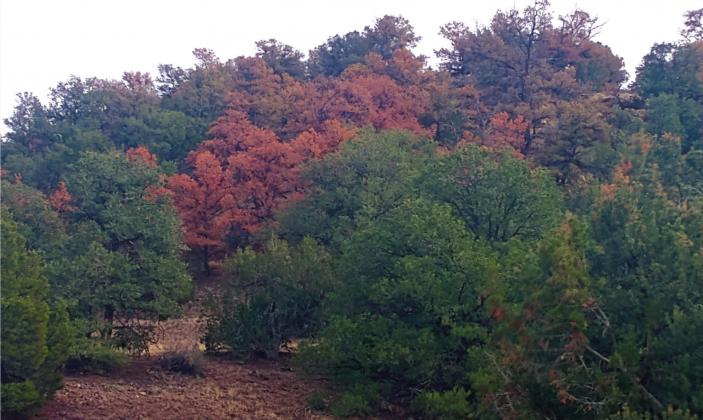Forest plunderers invade city trees
CIBOLA COUNTY, N.M. – Bark Beetles have invaded Cibola County and are winning the battle. The beetles have long lived in the region but until recently kept their destruction localized to the Cibola National Forest. At the midpoint of October, Cibola residents began alerting the Cibola Citizen to beetles they were finding in their trees, and now whole communities across Grants and Milan are being infected by the tiny invaders.
Bark Beetles are a threat to the ecosystem of Cibola County. Across the Zuni Mountains and on Mount Taylor the remains of piñon trees are scattered like rubble, a solemn reminder of the destruction these beetles can bring.
The Cibola National Forest has long battled these beetles, after wildfires crippled the forest’s natural ability to protect itself years ago, and a long-term, steady drought has taken hold of the trees; the forest’s natural ability alone isn’t enough to protect itself. While wildfires haven’t stressed trees inside the Grants area, the drought has. This has opened the door for these bugs to invade local trees.
Despite their invasion of Ci bola, Bark Beetles are important ecological creatures that play an important part in soil diversity and nutrient cycling. Bark Beetles come in many different forms, and are part of the Weevil family of beetles, they’re particularly noticeable due to their long snout which help in the burrowing process when searching for food and a place to nest.
Invasion of the city
During the hot Summer months, Cibola County’s residential areas water their grass often. As the heat fades and trees fall dormant for the Autumn, Cibola County winds down its watering, if not stopping completely. This has allowed the infestation of Bark Beetles to invade metropolitan trees.
Trees are still dependent on water, even when it’s the Wintertime, according to New Mexico State University Grants Extension Agent Chase Elkins. There are not many cures to a Bark Beetle infestation, but watering your tree, even in the Wintertime, is the best prevention and care method.
Elkins explained that one beetle won’t be enough to kill a tree, but that if one is noticeable, it is likely already too late to save the tree.
Bark Beetles burrow underneath the bark of a tree, slowly feeding off their host. In many instances the beetles lay larvae in special burrows called “egg-laying galleries.” When a beetle burrows into a tree it begins to emit a pheromone, or scent, that other beetles can follow as a sign that food was discovered, according to Elkins. When beetles smell those pheromones, they travel quickly to the nearest source of food and begin to feast. An infestation of beetles will force a tree into shock and kill the tree.
Trees that are well-watered will have better defense against those which have been struggling through the drought. Trees whose watering have been neglected will be easier targets for Bark Beetles as they are already in distress, and will not be able to defend themselves from invasion like their well-watered counterparts.
Destruction of the forest
Bark Beetles are important to the overall health of a forest, but as the old saying goes, “too much of a good thing is a bad thing.”
Typically, when a Bark Beetle burrows into a tree its because the tree was weak or in shock, when an infestation kills the tree, it helps to clean the forest of potential fuel for wildfires. Because of the long-term drought and years of other conditions which put Cibola’s trees in shock, the beetles are finding suitable nesting places everywhere. Bark Beetles are killing trees all across the county, which is actually increasing the amount of fuel for wildfires across the forest.
Throughout the Zuni Mountains and up Mount Taylor, the rotting remains of trees can be seen for hundreds of miles. In the early 2000s Bark Beetles were responsible for wiping out a significant potion of North-Central New Mexico’s piñon trees.
The Cibola Citizen reached out to the US Forest Service but did not hear back by press time.
Countering Bark Beetles
Unfortunately, there are no approved pesticides which can safely handle Bark Beetles, according to Elkins. Going and plucking the beetles out of a tree isn’t a good idea either, as they burrow beneath the bark of a tree, tearing off bark to get the bug would only further stress the tree.
As cold weather invades Cibola County residents are cutting dead wood from the forests for their fires. Elkins cautions all people with firewood stores to keep firewood away from their live trees. There may be beetles inside the dead wood collected for the fireplace, stacking the deadwood next to a live tree is like opening the door for a beetle invasion of the live tree.
Properly hydrating a tree by ensuring it has all the water necessary to protect itself is the best method to preventing and stopping a beetle infestation.
What exactly are Bark Beetles?
There are several species of Bark Beetle, but there are few as dangerous to the Cibola National Forest as the Western Pine Beetle, Roundheaded Pine Beetle, and the Ips Engraver. There are other types of Bark Beetle found in Cibola, but the above are the most prevalent and therefore most dangerous, according to a 2013 Forest Insect and Disease History of the Cibola National Forest report from the United States Department of Agriculture.
The Western Pine Beetle and the Roundheaded Pine Beetle, known as Dendroctonus adjunctus and Dendroctonus brevicomis respectively, are some of the larger culprits in Cibola’s current battle with Bark Beetles.
Piñon-Juniper trees are at increased risk across Cibola County from the Piñon Ips beetle, known in Latin as the Ips Confusus. Outbreaks of the Piñon Ips are primarily attributed to extended drought, with the United States Department of Agriculture releasing numerous papers about the growth of these beetles during high-levels of drought.
Ponderosa pine are at an elevated risk of attack from the Western Pine, Roundhead Pine, and Ips Engraver beetles. An Ips Engraver is known as Ips spp. According to the USDA report, Western Pine and Roundhead Pine beetles prefer to target larger diameter trees, while the Ips Engraver tends to look for smaller trees to feast on. It is not uncommon, however, to see all three families of beetles in a badly infested tree despite the size. These beetles have been a nuisance to Cibola National Forest since at least the 1920s, according to the report.
Spruce-fir trees on Mount Taylor and in the Sandia Mountains section of the Cibola National Forest are also under attack by the Spruce Beetle known as Dendroctonus rufipennis which likes to attack the Engelmann spruce trees, and the Balsam Bark Beetle known as Dryocoetes confusus which like to attack Corkbark Fir. These beetles also like to attack the larger diameter trees, especially “Spruce on well drained sites in creek bottoms.” Between 1963 and 1968 these beetles were attacking Mount Taylor, a 1976 report details the reasons behind the attack, citing “blowdown” or extremely heavy wind as a contributing factor to shocking the trees which allowed nesting areas for the beetles. By 1968 the attacks had ended and heavy woodpecker presence had decimated the beetle population. USDA reports that these beetles are uncommon in the Cibola area, but that does not mean they don’t exist in the region.
Beetles aren’t the only threat to Cibola National Forests trees; root disease and other insects are still major concerns to the vitality of trees across the forest and in Cibola County.
The current invasion of beetles is attributed to the climate, as drought is helping to creating the perfect conditions for Bark Beetle nesting. To protect trees from the attack, local exerts encourage watering of residential trees during the colder months.
New Mexico State University Grants boasts an extension program designed to help area locals with all thing’s nature related, offering advice for gardening, proper tree care, and insects. Call NMSU-G Extension Agent Chase Elkins at 505-287-9266 for more information about beetles or other discussions.


